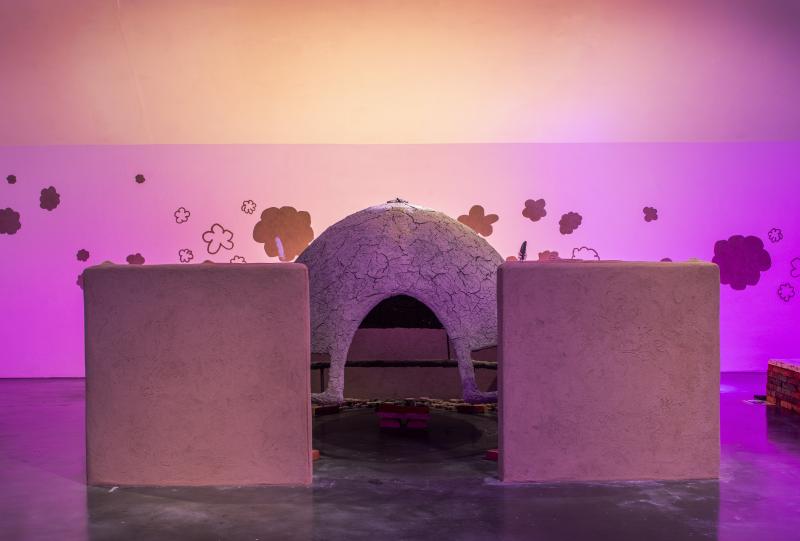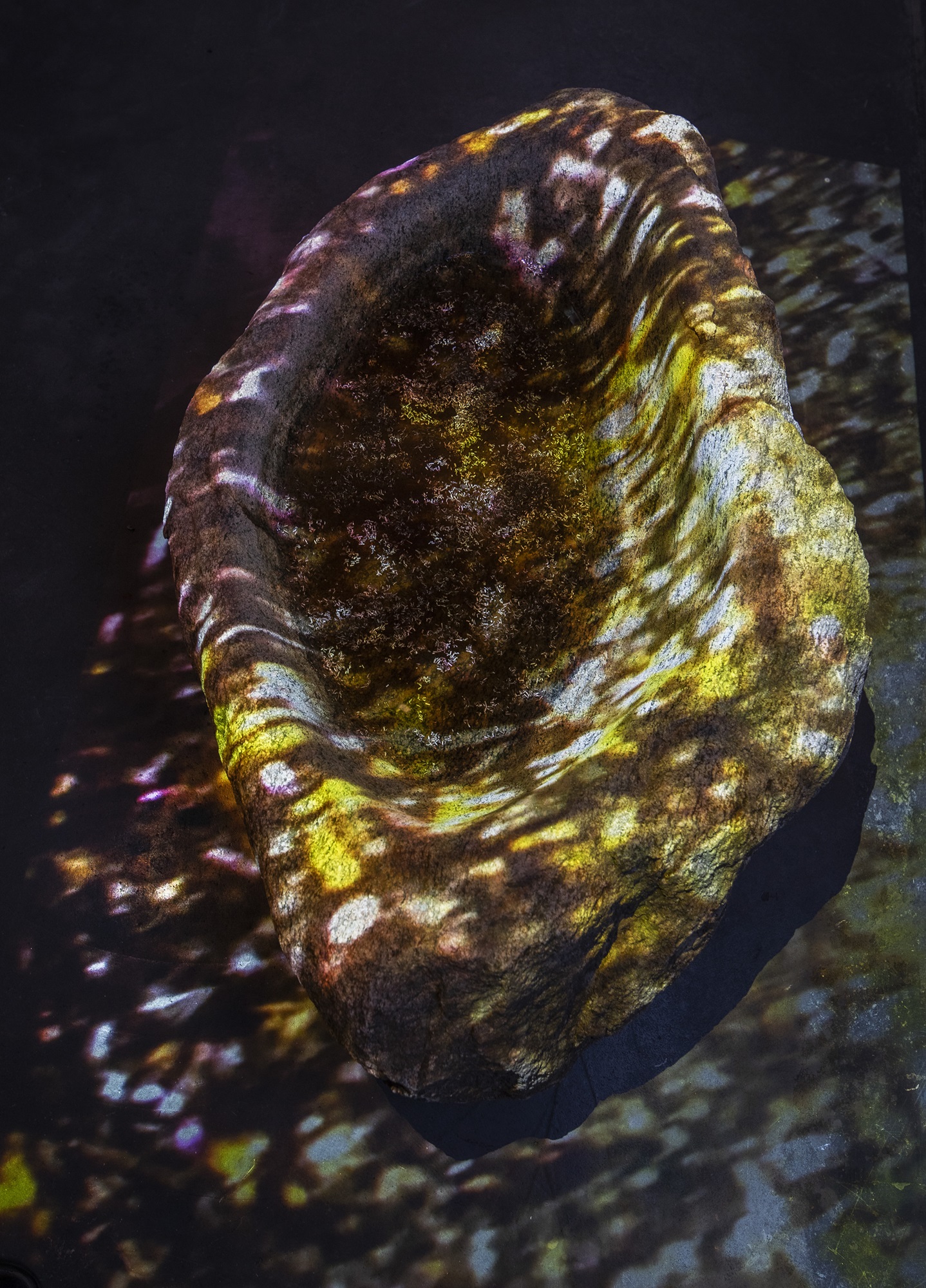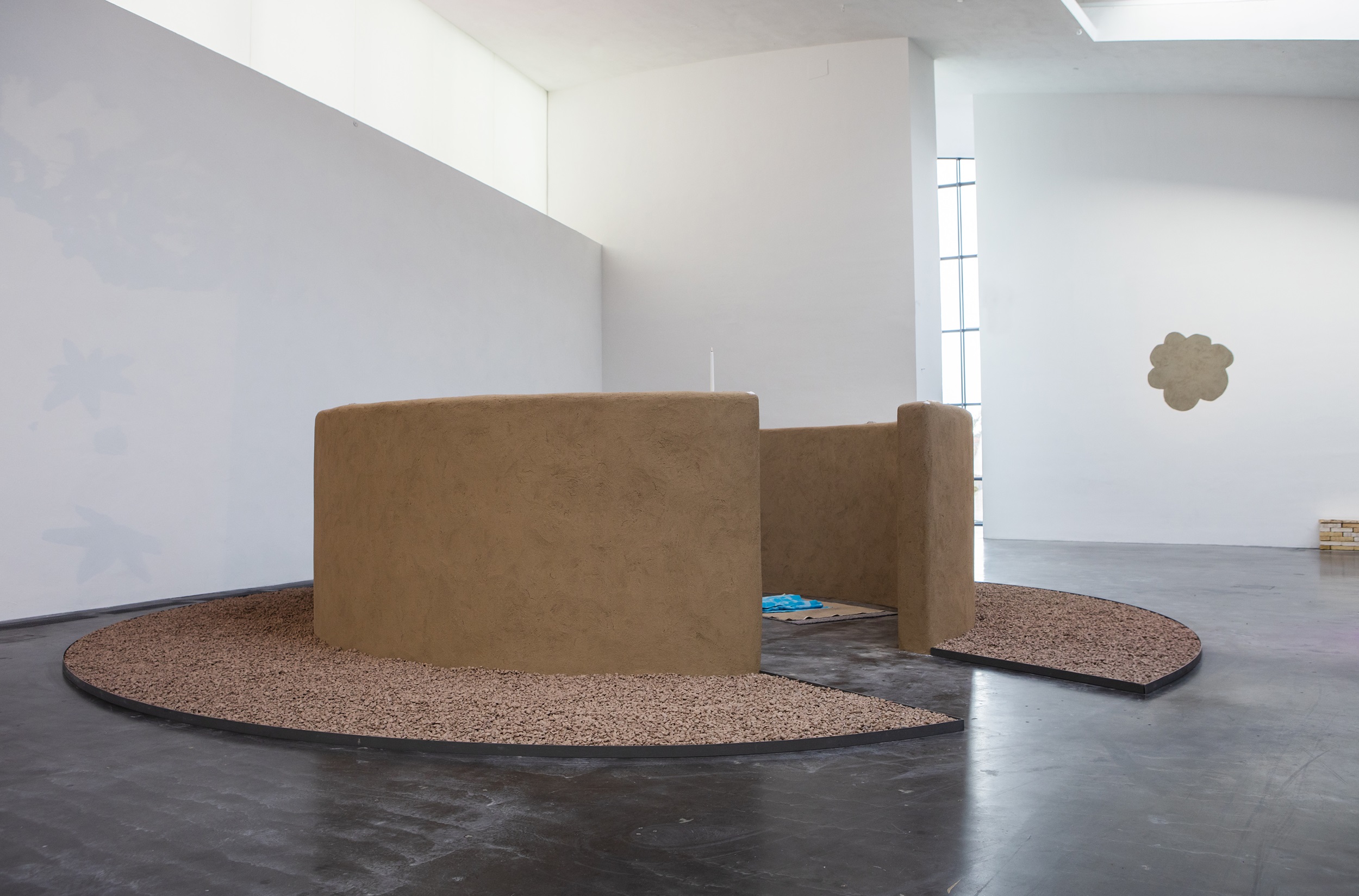Dineo Seshee Raisibe Bopape: (ka) pheko ye / the dream to come, Kiasma, Helsinki review - psychic archaeology | reviews, news & interviews
Dineo Seshee Raisibe Bopape: (ka) pheko ye / the dream to come, Kiasma, Helsinki review - psychic archaeology
Dineo Seshee Raisibe Bopape: (ka) pheko ye / the dream to come, Kiasma, Helsinki review - psychic archaeology
The South African artist evokes the Finnish landscape in a multisensory installation

Rosemary, heather and hops. These are just a few of the ingredients included in a special blend of herbal tea created by artist, Dineo Seshee Raisibe Bopape. Subtle yet deep in flavour, the amber coloured tea has a calming, if not soporific and dream-inducing effect.
Far from proverbially spilling the tea, Bopape’s latest installation (main picture) at the Kiasma invites us to sit, reflect and share a cup with her. Structured around ideas of communal dwelling and cross-cultural customs, memory and the unconscious, (ka) pheko ye – the dream to come encourages us to drink to the future whilst communing with and channelling the past. In this beautifully immersive and interactive exhibition, Bopape’s sense of prior histories, her sense of Finnish cultural rhythms and natural vicissitudes merge into and emerge through a very sensory sensibility of her own. The result in this explosion of sights, scents and sites is a reminder of what is contained in the naturally and culturally accreted landscapes around us: of the promise of tomorrow locked in the rocks of yesteryear; of the intangible "dream to come" espied in the very tangible and delectable leaves of your tea.
 It is with tea that Bopape begins this multisensory show. Floating in the narrow crook of a rock with psychedelic lights illuminating this liquid rich display, the same herbs used in her special blend of tea here evoke ancient rituals, hallucinatory vigils, transmogrifying properties, libations and propitiations (pictured right). Like in much of Bopape’s past work, herbs and rocks and rare resources of the earth are never just that: they are never just products to extract and exploit. Rather they contain worlds of wonder and experience, the poetic in the prosaic and the divine in the mundane. The first of many stations of transformation or posts from which to consider the spiritual hidden within the terrestrial, the immaterial within our material domains, the polychromatic rock and its herb-infused waters nurture within us a deeper sense of time and the powers dormant in all living things. Rock and water, flesh and spirit, body and soul, Bopape at once appeals to a primordial and preverbal language of our collective ancestral past, whilst also hinting at a vocabulary that is somewhat indicative of Finland’s own spiritual relationship to the land (the Sámi people, indigenous to the country, traditionally hold animistic and polytheistic beliefs whereby a soul or souls inhabit trees, plants and rocks).
It is with tea that Bopape begins this multisensory show. Floating in the narrow crook of a rock with psychedelic lights illuminating this liquid rich display, the same herbs used in her special blend of tea here evoke ancient rituals, hallucinatory vigils, transmogrifying properties, libations and propitiations (pictured right). Like in much of Bopape’s past work, herbs and rocks and rare resources of the earth are never just that: they are never just products to extract and exploit. Rather they contain worlds of wonder and experience, the poetic in the prosaic and the divine in the mundane. The first of many stations of transformation or posts from which to consider the spiritual hidden within the terrestrial, the immaterial within our material domains, the polychromatic rock and its herb-infused waters nurture within us a deeper sense of time and the powers dormant in all living things. Rock and water, flesh and spirit, body and soul, Bopape at once appeals to a primordial and preverbal language of our collective ancestral past, whilst also hinting at a vocabulary that is somewhat indicative of Finland’s own spiritual relationship to the land (the Sámi people, indigenous to the country, traditionally hold animistic and polytheistic beliefs whereby a soul or souls inhabit trees, plants and rocks).
Under this galaxy of cosmic light, I inhale rosemary and blackcurrant leaf – the same herbs I will later drink at home in London – and I am transported to distant climes and times, giddy with visions and notions, whilst very much remaining rooted to the spot in the space of the Finnish National Gallery, of which the Kiasma is a significant part. Tea, again, initiates us into this trans-historical exchange and spatial range; it is a welcome, homely and soothing taste, sight and smell to what could be a deliberately exciting but, for some, disconcerting conversion of a traditional "national" gallery.
Yet this is exactly the brilliance of Bopape’s installation. It wonderfully reinterprets the notion of what galleries, particularly those representing and upholding a nation’s "cultural" output, can do and mean. Although (ka) pheko ye – the dream to come borrows materials from the Finnish landscape and seeks to celebrate as well as imitate the fading light of Finland’s winter season, the exhibition demonstrates that one "nation" potentially represents and hosts many; one "land" infers and is formed by a million others; and one natural or synthetic object embodies an infinitude of meanings, functions and lives.
 In this, a kind of cosmic and psychic archaeology is at play, one where to stand in one spot and inhale the intoxicating fragrance of Finnish flowers is to also be placed on the threshold of a psycho-spiritual and psycho-geographical encounter; to pass into as well as witness the embedding and interaction of times, events and ties; to play the archaeologist and astrologer at once (for don’t they both indulge in dreaming across time zones?). Bopape’s exhibition, therefore, brings about a kind of psychic teleportation as much as it respects the geological and cultural formations which mark and structure the earth upon which we stand.
In this, a kind of cosmic and psychic archaeology is at play, one where to stand in one spot and inhale the intoxicating fragrance of Finnish flowers is to also be placed on the threshold of a psycho-spiritual and psycho-geographical encounter; to pass into as well as witness the embedding and interaction of times, events and ties; to play the archaeologist and astrologer at once (for don’t they both indulge in dreaming across time zones?). Bopape’s exhibition, therefore, brings about a kind of psychic teleportation as much as it respects the geological and cultural formations which mark and structure the earth upon which we stand.
Moving around the main gallery, this ambiguity of spaces and places, inner and outer, the particular and the universal, the individual and the collective, is further questioned and playfully explored in Bopape’s clay structures, wooden benches and artificially created "suns". Yes, the materials may come from Finnish territories and the environs of Helsinki – as with the hewn logs from Finnish forests that are used as low-levelled benches and the herbs from Frantsila farm diffused in the form of incense and tea – but they conjure and connect to other spaces and realities.
As with the tea, Bopape encourages us to rethink the familiar and register the extraordinary potential of the ordinary and the everyday. Seated inside the clay structures (Pictured above), we are encouraged to reclaim these interiors, identify our own hand in these calming and enclosing hearths of a kind. Bopape invites us to inhabit and make them our own, but also to recognise them as co-created spaces in the first place. Clay on the outside, but fortified within by man-made metal rods and poles, the bigger domed enclosures are reminiscent of ancient structures (like the temporary Lavvu or the permanent but naturally eroding space of the Goahti) historically attributed to the Sámi people of Finland. Yet these circular compounds also resemble something of the igloos, tipis, lapas and round huts of various indigenous communities around the world. By gesturing to these diverse indigenous habitations, Bopape not only commemorates the ingenuity and practises of indigenous communities, but also gestures towards the universality of such spaces and thereby to the shared sense of humanity and the collective communion available to us, irrespective of who we are or where we come from. Under the roof of these evocative communal hubs, Bopape (pictured below right) encourages us to dwell together, think together, drink together, and, of course, dream together.

For, isn’t that what a gallery should provide and embody? A space, a room, a bench within and upon which to remember, reconnect and reflect; a place that makes dreams real but which also compels us to dream of new realities. In the Kiasma, Bopape dares to hope and dream for and with Finland, but also beyond it. Extending the clay boundaries of the enclosures to the actual wall of the gallery, Bopape recreates an embrace from the earth, as visionary curator João Laia describes it. She envelopes us in this ever expanding yet enclosing border of clay (the stuff of life and death) with no exception, no exclusion of any person or thing, and encourages us within this natural circle and cycle to enter into the dreaming process and to embrace the earth from which we have come. In pink lights and shades of purple, in crushed Forget-me-nots and lullabies of love, in clay-clad animal figurines and floral projections, Bopape recreates a state of reverie in which we, too, can dream with her for future revelation, human connection and planetary restoration.
(ka) pheko ye – the dream to come celebrates the stuff that dreams are made of. In its own dreamy reconstruction of the structures, elements and hieroglyphics of our own cultures, Bopape opens a portal to the dreams of the past and gives us the keys to unlock those of the future. Sipping the herbal blend in London, reflecting on Bopape’s mesmerising and mind-altering work in Finland, I relish the fact that Raisibe will keep on "dreaming" such visions for us. How do I know this? I saw it in the tea.
rating
Explore topics
Share this article
The future of Arts Journalism
You can stop theartsdesk.com closing!
We urgently need financing to survive. Our fundraising drive has thus far raised £49,000 but we need to reach £100,000 or we will be forced to close. Please contribute here: https://gofund.me/c3f6033d
And if you can forward this information to anyone who might assist, we’d be grateful.

Subscribe to theartsdesk.com
Thank you for continuing to read our work on theartsdesk.com. For unlimited access to every article in its entirety, including our archive of more than 15,000 pieces, we're asking for £5 per month or £40 per year. We feel it's a very good deal, and hope you do too.
To take a subscription now simply click here.
And if you're looking for that extra gift for a friend or family member, why not treat them to a theartsdesk.com gift subscription?
more Visual arts
 'We are bowled over!' Thank you for your messages of love and support
Much-appreciated words of commendation from readers and the cultural community
'We are bowled over!' Thank you for your messages of love and support
Much-appreciated words of commendation from readers and the cultural community
 Lee Miller, Tate Britain review - an extraordinary career that remains an enigma
Fashion photographer, artist or war reporter; will the real Lee Miller please step forward?
Lee Miller, Tate Britain review - an extraordinary career that remains an enigma
Fashion photographer, artist or war reporter; will the real Lee Miller please step forward?
 Kerry James Marshall: The Histories, Royal Academy review - a triumphant celebration of blackness
Room after room of glorious paintings
Kerry James Marshall: The Histories, Royal Academy review - a triumphant celebration of blackness
Room after room of glorious paintings
 Folkestone Triennial 2025 - landscape, seascape, art lovers' escape
Locally rooted festival brings home many but not all global concerns
Folkestone Triennial 2025 - landscape, seascape, art lovers' escape
Locally rooted festival brings home many but not all global concerns
 Sir Brian Clarke (1953-2025) - a personal tribute
Remembering an artist with a gift for the transcendent
Sir Brian Clarke (1953-2025) - a personal tribute
Remembering an artist with a gift for the transcendent
 Emily Kam Kngwarray, Tate Modern review - glimpses of another world
Pictures that are an affirmation of belonging
Emily Kam Kngwarray, Tate Modern review - glimpses of another world
Pictures that are an affirmation of belonging
 Kiefer / Van Gogh, Royal Academy review - a pairing of opposites
Small scale intensity meets large scale melodrama
Kiefer / Van Gogh, Royal Academy review - a pairing of opposites
Small scale intensity meets large scale melodrama
 Jenny Saville: The Anatomy of Painting, National Portrait Gallery review - a protégé losing her way
A brilliant painter in search of a worthwhile subject
Jenny Saville: The Anatomy of Painting, National Portrait Gallery review - a protégé losing her way
A brilliant painter in search of a worthwhile subject
 Abstract Erotic, Courtauld Gallery review - sculpture that is sensuous, funny and subversive
Testing the boundaries of good taste, and winning
Abstract Erotic, Courtauld Gallery review - sculpture that is sensuous, funny and subversive
Testing the boundaries of good taste, and winning
 Edward Burra, Tate Britain review - watercolour made mainstream
Social satire with a nasty bite
Edward Burra, Tate Britain review - watercolour made mainstream
Social satire with a nasty bite
 Ithell Colquhoun, Tate Britain review - revelations of a weird and wonderful world
Emanations from the unconscious
Ithell Colquhoun, Tate Britain review - revelations of a weird and wonderful world
Emanations from the unconscious
 Rachel Jones: Gated Canyons, Dulwich Picture Gallery review - teeth with a real bite
Mouths have never looked so good
Rachel Jones: Gated Canyons, Dulwich Picture Gallery review - teeth with a real bite
Mouths have never looked so good

Add comment